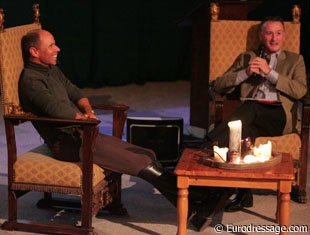
This year’s forum keynote speaker was American champion Steffen Peters. The sympathetic German-born American became the centre of attention when he finished fourth at the 2008 Olympic Games, won the 2009 World Cup Finals in Las Vegas and beat the world’s best riders at the 2009 CDIO Aachen aboard Akiko Yamazaki’s Dutch warmblood gelding Ravel (by Contango). Peters was invited to the 2009 Global Dressage Forum to present his training methods and to meet the man behind the rider.
In intimate man-to-man conversation with Richard Davison, Peters opened up about his daily life with horses and his wife Shannon. The Peters family runs a training stable near San Diego, California, where 63 horses are boarded and taking care of by a staff of 14. One weekend a month, Steffen kicks back with his wife and relaxes. "We enjoy the weather," he said, "or watch movies at home in our own home theatre."
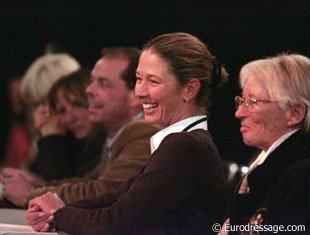 Steffen Peters started riding on ponies at an early age and got his first horse from his father when he was a teenager. "He was tricky and obnoxious and my sister and I landed in the dirt quite a few times," Steffen admitted. Peters ended up with his long time trainer Johann Hinnemann thanks to his mathematics high school teacher, who was Hinnemann's wife. When he was 19-yeards old Steffen moved to the States to work at Lauie Falvo's barn and never left. He booked his first major success at the 1996 Olympic Games in Atlanta where he won team bronze on the 18-year old Udon (by Darling Boy), that same first horse bought by his father.
Steffen Peters started riding on ponies at an early age and got his first horse from his father when he was a teenager. "He was tricky and obnoxious and my sister and I landed in the dirt quite a few times," Steffen admitted. Peters ended up with his long time trainer Johann Hinnemann thanks to his mathematics high school teacher, who was Hinnemann's wife. When he was 19-yeards old Steffen moved to the States to work at Lauie Falvo's barn and never left. He booked his first major success at the 1996 Olympic Games in Atlanta where he won team bronze on the 18-year old Udon (by Darling Boy), that same first horse bought by his father.
When Davison asked Steffen what his most embarrassing movement ever was, he replied meeting President Clinton at the White House in 1996. "After we shook the president's hand we went outside the blue room where a statue was of Georg Washington," Peters said. His American team mates started dressing up the statues with sun glasses, a dressage coat and medals and by the time it was Peters' turn to take a photo with the statue, Clinton came in the room and said, "it looks like you guys are having fun around here."
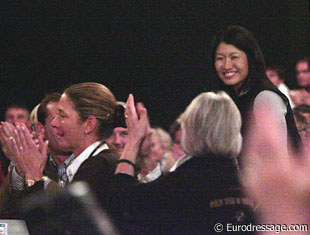 As an introduction Peters showed a video tape of his growing partnership with Ravel. "We sweet-talk too many situations and kept everything in the video real," Steffen admitted. When the stallion arrived from The Netherlands in the U.S.A. he was obnoxious, unfocused and had several training issues including sticking out his tongue. Ravel was gelded upon arrival to calm down and in order to fix the tongue problem Peters rode the dark bay in a rubber snaffle for two months. By doing so he restored the trust between horse and rider and established an honest connection with the horse’s mouth. Ravel got injured later on and it was very hard bringing him back to full recovery, but fortunately Ravel made it and went on to become the shooting star at the Olympics. The video was a very honest statement about the shared struggle of the horse, owners and rider.
As an introduction Peters showed a video tape of his growing partnership with Ravel. "We sweet-talk too many situations and kept everything in the video real," Steffen admitted. When the stallion arrived from The Netherlands in the U.S.A. he was obnoxious, unfocused and had several training issues including sticking out his tongue. Ravel was gelded upon arrival to calm down and in order to fix the tongue problem Peters rode the dark bay in a rubber snaffle for two months. By doing so he restored the trust between horse and rider and established an honest connection with the horse’s mouth. Ravel got injured later on and it was very hard bringing him back to full recovery, but fortunately Ravel made it and went on to become the shooting star at the Olympics. The video was a very honest statement about the shared struggle of the horse, owners and rider.
Educated by Johann Hinnemann, Peters has remained loyal to the classical principles and stressed that suppleness and an honest and light contact with the bit are essential to train a dressage horse correctly.
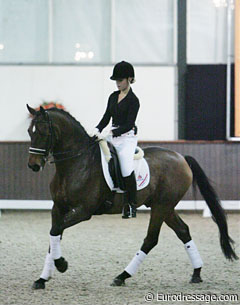 Four advanced horses came into the arena which Steffen trained from the ground. Dutch Junior Rider Sanne van Grotel and her 15-year old KWPN bred Melvin (by Flemmingh) worked on tempo transitions and half-halts to get the bay gelding lighter in the contact. "You have to ask yourself simple questions," Steffen explained. "Is my horse really moving forward? How is the connection? Everything is about your standard and expectations. What can I expect from his age, temperament? Is every single aid understood?" With Melvin, increased self-carriage was the goal to work for.
Four advanced horses came into the arena which Steffen trained from the ground. Dutch Junior Rider Sanne van Grotel and her 15-year old KWPN bred Melvin (by Flemmingh) worked on tempo transitions and half-halts to get the bay gelding lighter in the contact. "You have to ask yourself simple questions," Steffen explained. "Is my horse really moving forward? How is the connection? Everything is about your standard and expectations. What can I expect from his age, temperament? Is every single aid understood?" With Melvin, increased self-carriage was the goal to work for.
Remy Bastings and his Hanoverian Riverdance (by Wolkentanz II) was a bit slow behind and Peters asked the rider to engage the horse’s brain more in order to get him quicker. "We are looking for a horse that is perfectly controlled all the time," Peters said. The horse struggled with the pirouettes but Steffen reassured the rider that “every mistake your horse makes is a training opportunity. Your horse shouldn’t lose his confidence.”
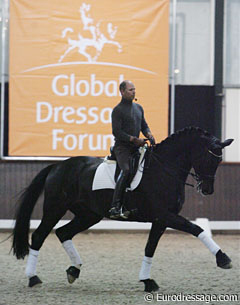 Afterwards Peters rode a gigantic 9-year old black Jazz offspring called Toots. The black has enormous movements but Peters wanted to see if he was also able to collect them properly. “It is easy for us to get fooled with his big cadence,” he said. “I would compromise on expression but not on connection and controlled energy.” Toots proved to be incredibly rideable and was a pleasure to watch. The gorgeous black only had problems with the traversal movements in which he needed to more sensitive to the sideway aid. "The spur is a reminding aid, not a supportive one. Making the calf aid a driving aid is hard for our body to adapt to. Peters disclosed that he prefers to hold the handle of a whip diagonally in his hand as it gives him more control and easier access when he wants to give light taps on the croup for engagement.
Afterwards Peters rode a gigantic 9-year old black Jazz offspring called Toots. The black has enormous movements but Peters wanted to see if he was also able to collect them properly. “It is easy for us to get fooled with his big cadence,” he said. “I would compromise on expression but not on connection and controlled energy.” Toots proved to be incredibly rideable and was a pleasure to watch. The gorgeous black only had problems with the traversal movements in which he needed to more sensitive to the sideway aid. "The spur is a reminding aid, not a supportive one. Making the calf aid a driving aid is hard for our body to adapt to. Peters disclosed that he prefers to hold the handle of a whip diagonally in his hand as it gives him more control and easier access when he wants to give light taps on the croup for engagement.
At the end of the session, Peters mounted Imke Schellekens’ Ferero (by Ferro). The horse has a mediocre walk and Steffens tried to improve the walk by riding many halt-walk transitions to get a clear 4-beat rhythm. He also rode a few piaffe and passage steps with the bay gelding. "If I don't have the energy in passage, I won't have it in piaffe."
Peters professed a state of highly "conscious riding" in which the rider is aware of his own mental process and strives to stay honest with his horse. He was a breath of fresh air and brought the magic to the Global Dressage Forum. His consistency and humility were exemplary for many dressage trainers.
Text and photos copyrighted Astrid Appels/Eurodressage.com
No Reproduction allowed without explicit permission